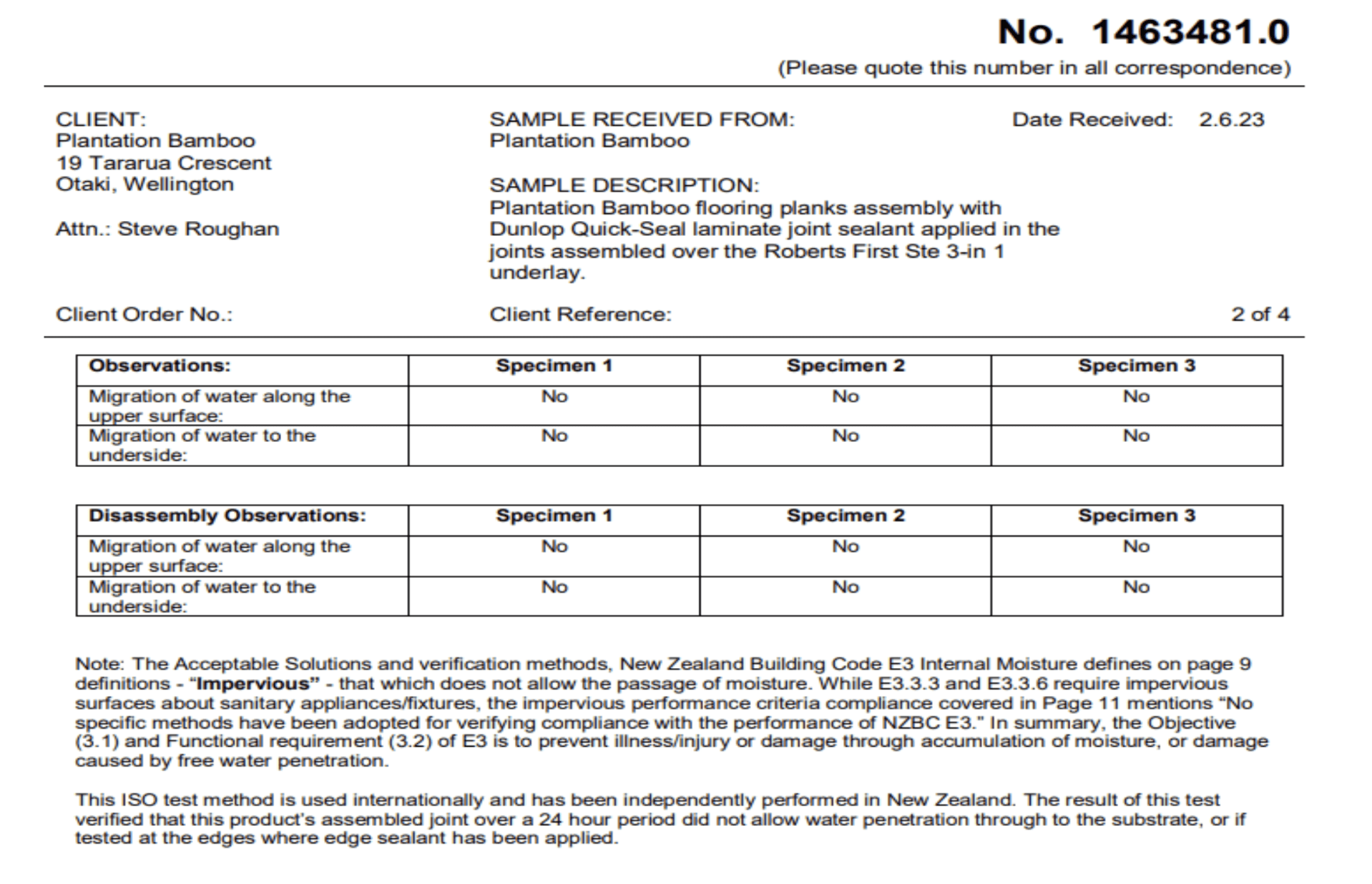The New Zealand Building Code changes: E3/AS1 Acceptable Solutions
Bamboo flooring in wet areas such as kitchens, laundries and toilet areas
The information below outlines the requirements to ensure that the installation of bamboo flooring in kitchen, laundry and toilet rooms complies with the New Zealand Building Code as an “Acceptable Solution”.
Introduction
With the latest change to the E3/AS1 Acceptable Solutions building code (which came into effect 4th November 2021) the number of flooring options that are considered an acceptable solution in wet areas has dropped to three (from seven) and excludes timber and timber-based products – like bamboo flooring.
This means that from 5 November 2021, additional Building Code changes came into effect, impacting how wood (and bamboo) flooring is to be specified in wet areas. This change is only relevant to timber flooring being specified in wet areas such as kitchens, bathrooms, toilets and laundries – so does not include living areas, dining spaces, hallways, bedrooms and the like.
Kitchens are now included as areas that have sanitary fixtures, and floor finishes falling outside those covered in the
Amendment 7, require an Alternative Solution to satisfy the Building Consents Authority (BCA).
Any projects consented prior to 4th of November 2021 are exempt because both Amendment 6 and 7 are a means of compliance.
The above changes were made so the Acceptable Solution (E3/AS1) better aligns with the requirements of the Building Code which states in Section E3.3.3.
“Floor surfaces of any space containing sanitary fixtures or sanitary appliances must be impervious and easily cleaned”.
Product: Plantation Compressed Bamboo Flooring & Bamboo Elite Flooring
When used in accordance with the below installation methods, the above bamboo flooring products may be used in kitchens, laundry and toilet rooms (wet areas) as an Alternative Solution (as defined above).
Service History
Plantation Bamboo have supplied in excess of 80,000m2 of bamboo flooring products in the NZ market for over 16 years across a range of residential (and some commercial) applications. The majority of customer installations have been successfully fitted in kitchen areas, with proven results.
In addition, bamboo flooring has been used extensively over a long period of time in global markets including installations in kitchens and laundries.
E3 – Impervious
Impervious is defined in the E3/AS1 Acceptable solution as “Impervious – that which does not allow the passage of moisture”. While performance clauses E3.3.3 and E3.3.5 require impervious surfaces around sanitary fixtures/appliances, there are no verification methods provided. Refer to page 11 of E3/AS1 which states “No specific methods have been adopted for verifying compliance with the Performance of NZBC E3”.
As there are no verification methods provided to test for an impervious surface, Plantation Bamboo engaged NZWTA, an accredited laboratory to conduct independent testing on the passage of moisture for our bamboo flooring. The ISO test method employed is used internationally and has been independently performed in New Zealand.
The result of this testing verified that Plantation Bamboo flooring’s assembled joint system, over a 24-hour period did not allow water penetration through to the substrate where edge sealant had been applied. The bamboo flooring was assembled for testing with a suitable joint sealer applied on all joins, over a Roberts First Step 3-in-1 underlay.
An excerpt from the test report includes:

Please enquire for a copy of the test report, if required.
Surface layer and joint system
Plantation bamboo flooring features an impervious and easily cleaned surface, being pre-finished with multiple layers of UV applied coatings. In addition, the locking system, (on all four edges of each board) provides a tight glueless joint, with a wax coating that inhibits ingress of moisture without the need for additional sealing. This provides splash protection.
When Unika ClicSeal Moisture Protection Sealant is applied to joins within 1.5 metres of the water source the flooring will be fully sealed and be impervious to water penetration. Note: Dunlop Quck-Seal Laminate Joint Sealer is no longer sold in NZ so the above ClicSeal sealant is a suitable replacement and commonly used.
Installation in “wet areas”
In order to meet the Alternative Solution requirements, when Plantation Bamboo flooring is being installed in kitchens, laundries or toilets the following additional safeguards (in addition to the normal installation instructions) should be carried out within at least a 1.5 metre radius of the water source in that room:
Apply a coating of Unika ClicSeal Moisture Protection Sealant (available from Plantation Bamboo) to all joins in the bamboo flooring within at least 1.5 metres of the water source, to fully seal the joins against water penetration. In addition, a thin bead of the sealant should be applied to the perimeter of the bamboo flooring, to seal where the floor meets the skirting boards or cabinetry (“toe kicks”, etc), along with any penetrations of the flooring (pipes etc).
Waterproof Membrane
For “floating floor” installation – prior to installation of bamboo flooring on a concrete slab or other sub-floor, a
waterproof membrane/underlay is required (such as Roberts First Step 3 in 1 underlay).
For direct fix (glue down) installation – the subfloor needs to be sealed with a suitable waterproof membrane.
See the relevant installation instructions for more detailed information.
Easily Cleaned
Bamboo flooring is easily cleaned with a broom, standard vacuum or damp micro-fibre mop. Please refer to the cleaning and care instructions

